10 Onion Growing Problems and How to Prevent Them
Are onions staples in your kitchen? Do you want to grow more of them in your garden, like I do?
We currently have over 300 planted in our garden! After harvest, I store onions whole for a few months and then freeze and dehydrate the rest. Each year I have a goal to grow enough to last me until the next year. Although I haven’t achieved that goal quite yet, I get closer each season.

You make think since I have so many planted that growing onions is a no-brainer for me.
The truth is, onions are a little bit (ok a lot a bit) finicky. I plant so many because no season is the same, and in my Arkansas climate, roller coaster temperatures can cause major setbacks in the size of the bulbs.
But because I’m relentless in my pursuit of more and more onions, I have learned a lot about growing onions the last eight seasons, and I’ve definitely learned a lot of what not to do.
I dive into the details on our latest podcast. You can listen to that below or continue reading.
Common onion growing mistakes
*links in this post contain affiliate links; if you click through and make a purchase, this site earns a commission at no extra cost to you.
Planting the wrong onion types
You may be surprised to learn that one of the most common mistakes when it comes to growing onions is planting the wrong type. This is especially true if you’re buying your seeds, sets, and transplants from an online source. You have the option of buying short-day, long-day, or intermediate-day (also called day-neutral) onions, and which ones you choose makes all the difference in whether you harvest bulbs or just green onion tops.
If you are wanting large bulbed onions rather than green onions, you will plant the type of onions depending on your latitude. If you are in the US, find your location on this chart to determine which kind of onion is best suited for you. In many areas, like mine, I can plant both short-day and intermediate-day onions, but long-day onions would never bulb for me.
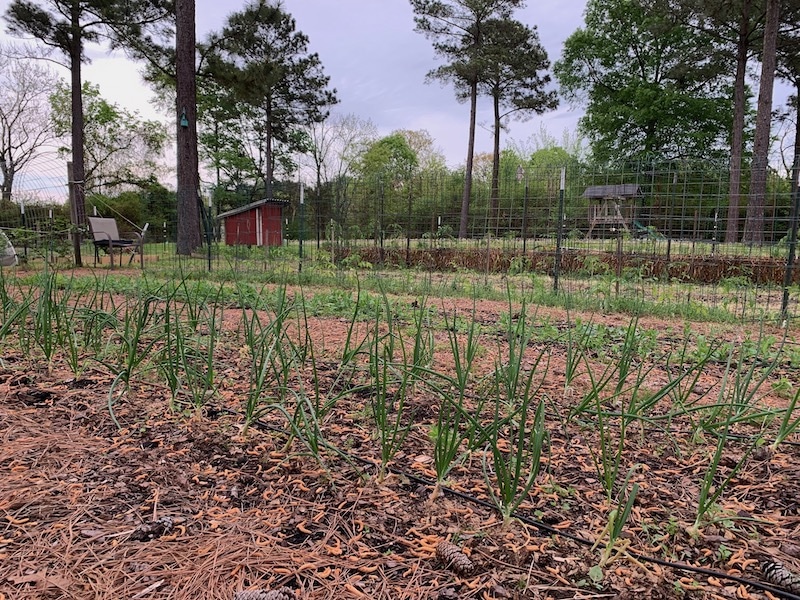
Planting sets instead of transplants and vice versa
If you are new to onions, sets of onions are those little tiny onion bulbs that look like mini onions. Transplants look like green onions with a long green stem and roots at the bottom. The mistake I personally made my first season was walking into the store and grabbing the sets, hoping to would grow large bulbs. Sadly, all I harvested that year were green onions.
Now, it’s impossible to say for sure, but more than likely those were long day onion sets, and quite honestly, they were more than likely meant to be grown as green onions in my area. They grew very long, beautiful stems…but no onion bulbs. The next year, I learned my lesson, bought the transplants and they grew into huge bulbous onions.
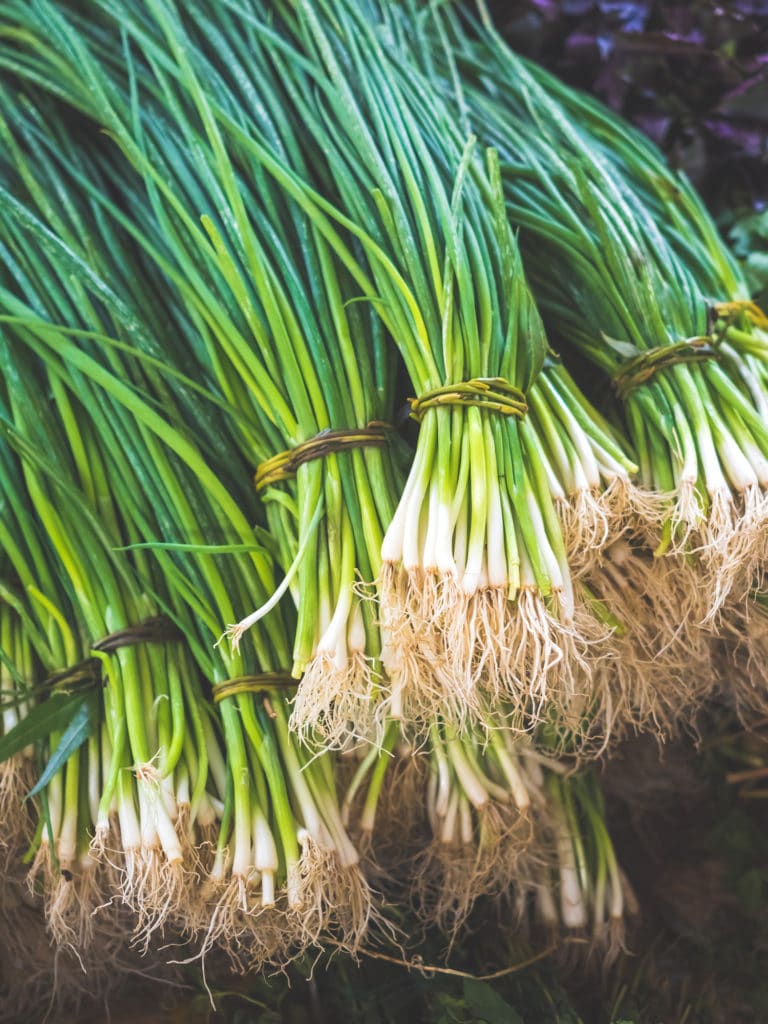
From this experience, made the incorrect assumption that sets are for green onions and transplants are for onion bulbs. But then I started to see northern friends posting about growing sets and having huge success. So, then I started to wonder? What is actually right here?
After digging deep into this subject, I have found that even amongst the credible university extension websites, the answers vary, depending on where the source is located.
This has led me to believe that learning how to grow onions, more than any other crop perhaps, is entirely dependant on the climate you live in. The very best source you can use is your local university extension (find yours here). I — and other gardeners online — don’t live where you live and our experience most likely won’t be the same as yours.
As you’re researching how to grow onions (and which ones to plant, when to plant, when to expect a harvest, etc.), be SURE that you know where the source you’re reading about is located.
But back to what type of onions to plant, the bottom line is this — whether you plant sets or transplants, make sure you choose the right day-length onion.
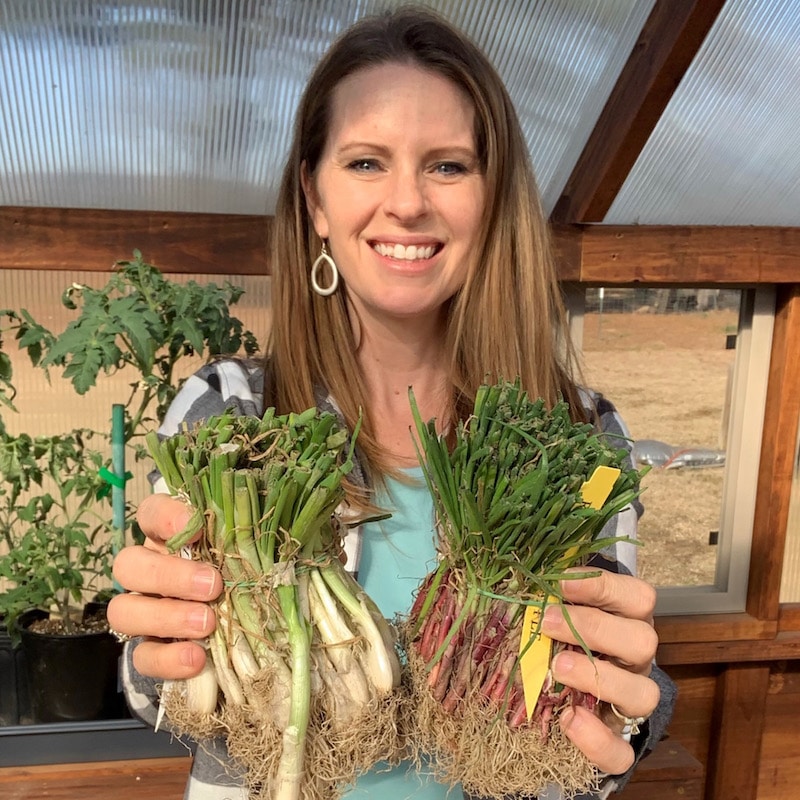
Planting too large of transplants and sets
Once you know what type of onion to plant, let’s look at some other common mistakes in growing onions.
When you buy your transplants or sets from your local garden supply store or online (this is my favorite source for buying onions), there’s a natural tendency to pick the largest onions.
However, the ideal transplant size is the width of a pencil!
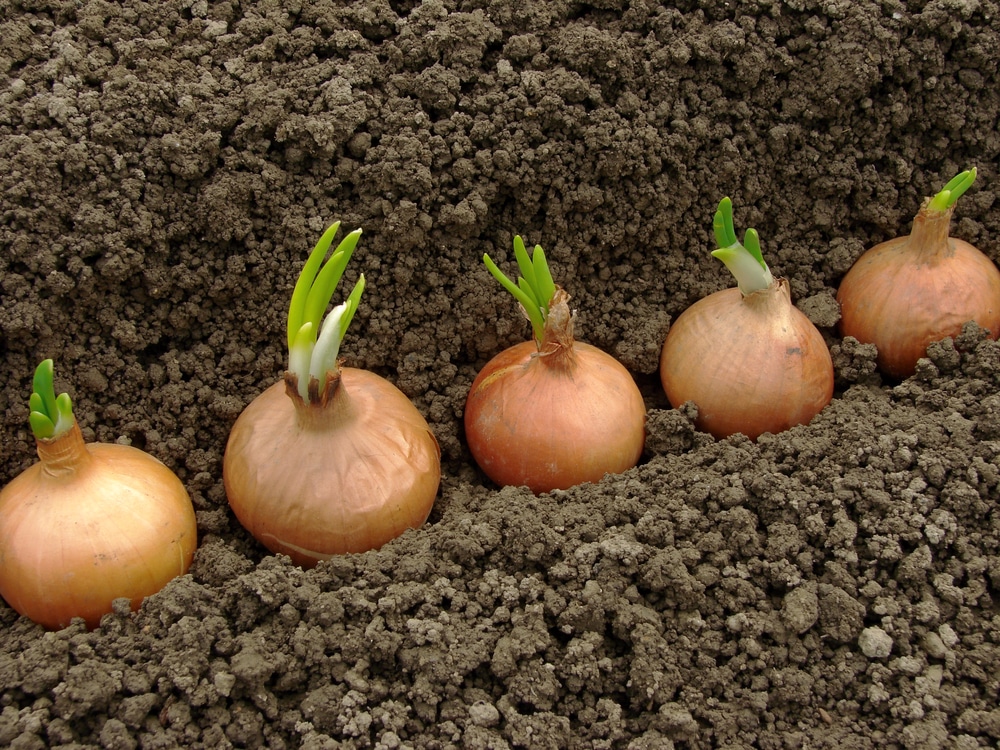
The same is true when it comes to onion sets. Separate your sets and save the biggest ones for green onions and your medium ones for larger bulbs.
Growing from seed
The thorn in my side–growing onions from seed. This year I am hopeful, but up to this point, I’ve not been successful in growing onions from seed. One of the bigger mistakes when trying to grow from seed is that people wait too late to sow their seeds. This should be one of the very first crops you sow seeds for.
While northern gardeners who enjoy a long onion growing season into the summer will have more flexibility with this date, those of us in the South are on the clock since onions start bulbing sooner. Those onions need plenty of time to develop the greens that will nourish the bulbs. Because of that, we need to start our seeds about 10-12 weeks before the average last frost date.
Planting transplants too deep and too close together
Transplants should be planted about one inch deep. A trick I use is I plant them deep enough for them to stand up straight.
Also, after trial and error, I’ve found that planting the transplants 6 to 8 inches apart produces larger bulbs than when spaced closer together. Onions are water- and nutrient-hungry, and they need ample soil space from which to draw water and nutrients.
Not feeding the onions enough
Onions are heavier feeders than you would think for such a small plant. Most reputable onion growers (including the farm where I buy my onion transplants) recommend high-nitrogen synthetic fertilizer. But as an organic gardener, I don’t put any synthetic fertilizer on my garden. This doesn’t mean that I can’t feed my soil and plants organically, though.
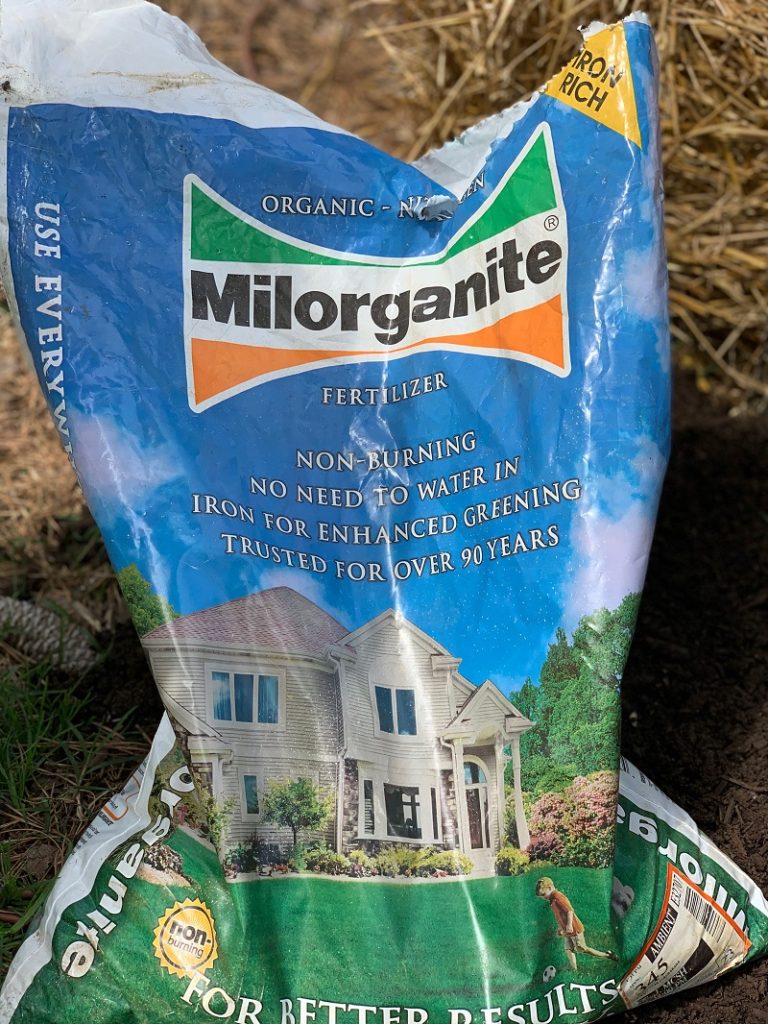
Good leaf growth is what feeds your bulbs when the plants switch to the bulbing process. I add Milorganite into the garden ahead of planting because it’s an organic option. In the fall or early spring, I may add chicken manure. I also sometimes add corn gluten meal to sprinkle around the plants. This offers both an extra dose of nitrogen and weed suppression.
Not enough water and/or too much water
Onions love water! They can bolt if they aren’t well hydrated (more on bolting below). So, make sure you make watering onions a regular part of your garden routine if Mother Nature doesn’t provide plenty in the spring.
On the flip side of that, onions don’t love growing in waterlogged soil, so try your best to ensure the soil is well-draining and doesn’t hold water long. If your soil, like mine, contains a high percentage of clay, consider planting onions in a raised bed instead.
Not enough sun
It’s easy to assume (as I did) that onions don’t need as much sun because they aren’t fruiting plants, but in fact, that isn’t true. Onions love full sun, particularly in the early part of their growth. Keep this in mind if you do any companion planting. If you do plant them next to larger plants, try to time the planting where the larger plants are full size later in the onions’ growth.
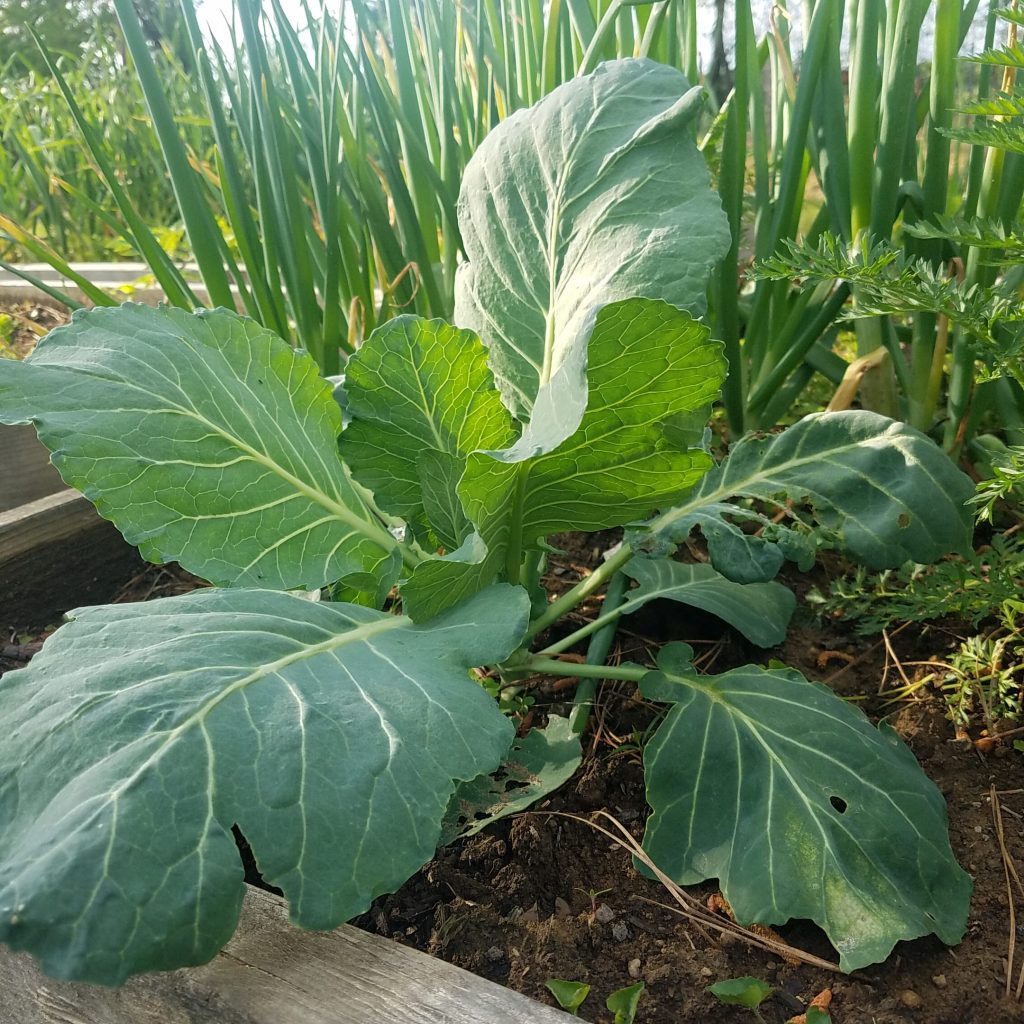
Competing with weeds
We know now that onions are heavy feeders and need lots of water. This means, they can not be competing with weeds that are looking for the same thing. Make sure you weed often and keep your onion area free of the weeds, especially early on in the planting when the rains are more current.
I have to hand-weed when onions are small, but once they grow larger, a thick layer of mulch is a must. This also helps keep the soil temperature down, which is important to prevent premature bolting.
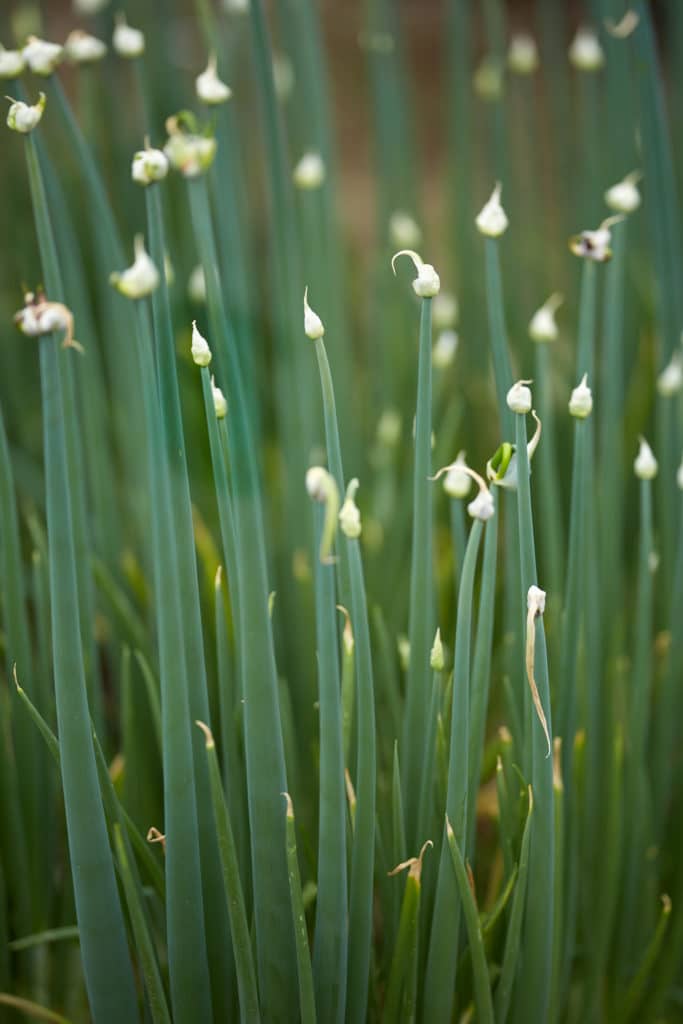
Bolting
As a lot of other plants do, onions may bolt. You’ll know it’s starting to happen when the center stalk develops a small tear-drop-shaped white tip. From there, the center stalk grows taller and tougher, and the tip enlarges. This will eventually develop into a flower.
While these flowers are beautiful and feed our beneficial insects, it means that bulb growth has stopped as the plant shifts to seed production.
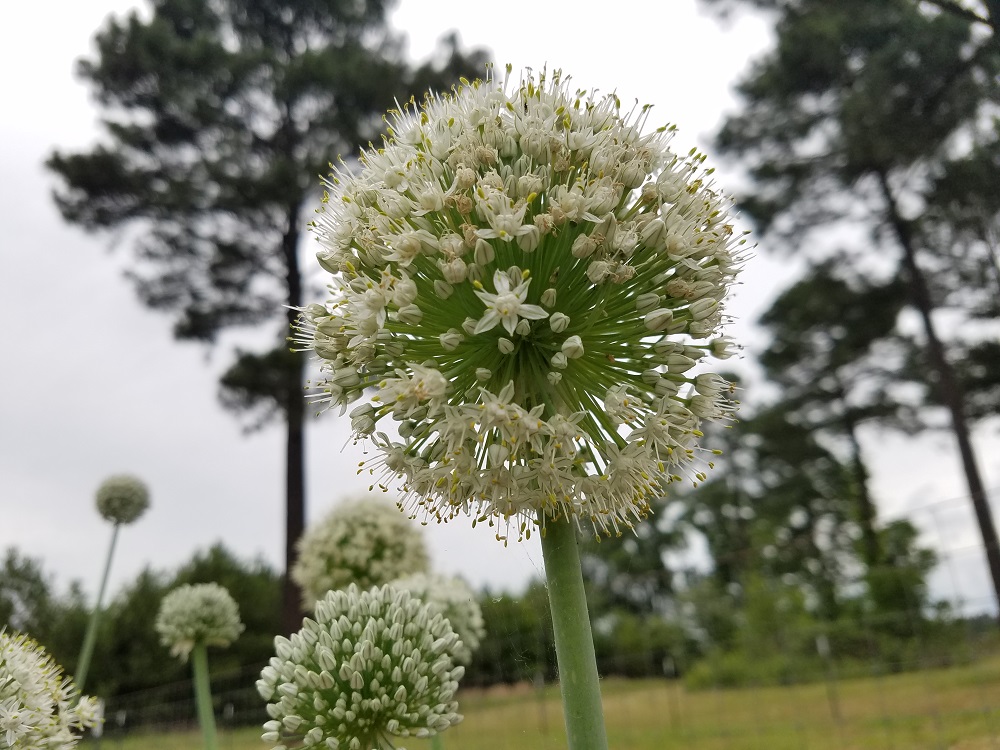
When an onion bolts, this also means your bulb isn’t a candidate for storage. But all is not lost.
At the first sign of the bolting onion, it’s best to harvest. You can use the onion now or chop and freeze or dehydrate. It won’t store long in its bulb form, and the longer you wait, the tougher the inside of the onion will get. This will make it even harder to use.
Most of the time, bolting is caused by rising temperatures, but often, bolting is triggered by fluctuating temperatures. If you live in my zone 7b, then you know hot to cold temperatures are very common in my area.
There are a couple of ways to try and help your onions avoid these extreme temp changes. One is that you can mulch around your onions after the spring rains but before the weather gets hot. Also, make sure you start watering extra during those hot summer days.
Covering up onion bulbs that have popped out of ground
If you avoid the bolting (which is always my goal!), as harvest nears, the onion bulb starts to pop out of the ground. It’s tempting to cover these back up (like you would potato plants), but this actually can cause the neck to rot, keeping it from being able to store properly after harvest.
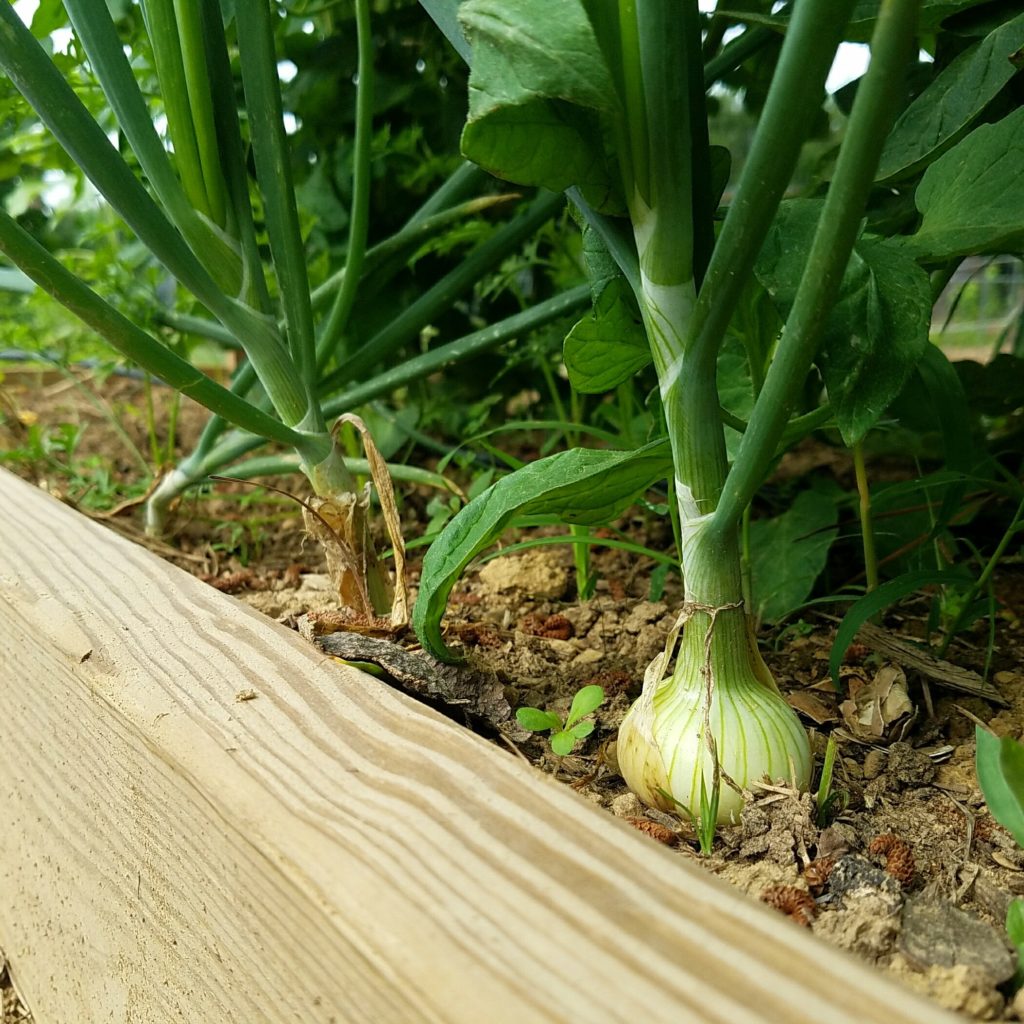
Breaking the stems
Often, gardeners break the necks or stems of their plants to lay down on top of the soil at the end of the growing process. They do this in an attempt to get the plant to bulk up the bulb below.
Unfortunately, the opposite occurs. The bulb below the soil is being fed by the sugars that grow in the leafy greens on top. When you damage these greens, you cut off the final stages of bulb production. When the bulb production has stopped, and the onion has reached maturity, the leaves will fall over on their own. It’s at that point we know they are ready to harvest!
—
To wrap up this discussion, I want to reiterate one thing. Of all the advice you read about growing onions, always consult your local university garden extension website, visit them in person. Or ask local growers. Onions, in my experience, are the most variable in their growth and what they need, based on the location in which they are growing.
And if you’re still in the trial and error camp in your quest to grow large onion bulbs, welcome! You’re in good company. Let’s navigate this together.
Do you get overwhelmed with garden planning?

Subscribe here for my best tips to plan your garden in just 7 days -- all for FREE.
Plus, I'll send you my "In the Garden E-mail" on Fridays, periodic updates on garden resources relevant to you, and you'll receive access to my entire bank of free garden downloads!
You are also agreeing to our privacy policy.


FYI
Your onion info was great, but why did you suddenly greatly increase your rate of speech? I do not hear well, but your speech rate is usually quite understandable. There were times, in listening to the onions presentation, when I thought you were speaking rapid Spanish and I missed lots of information. I was able, however, to go to the text.
Know, however, that I greatly appreciate your efforts and information, and I find it most useful !!
Thank you,
J. DeBoer (77) Indiana
I don’t remember increasing my rate of speech. If I did, it was probably to try to get the information out more quickly without a super-long podcast episode. However, I do wonder if maybe whatever device you listened on decided to speed up on its own. Mine does that all the time! On podcast players, you can set the pace to 1.5 times or 2 times the normal speed, and while it is a setting we manually control, I’ve had my phone do it seemingly on its own. So I would venture that was more likely what happened.
Can I still apply the Espoma corn gluten meal in my garden to help inhibit weeds next to all my vegetable plants any time of the growing season?
Yes, as long as you’re not sowing any seeds since it helps prevent seed germination.
I grow all my onions from seed in my high tunnel here in Tennessee in zone 7. I start them the last week in January or the first part of February. I use pelleted seeds [Expression is the name of them. ] and my bed is pretty much weed free. I put the seeds about 2-3 inches apart. I let them grow there without transplanting until they are mature except the ones we use for green onions. I do no dig and have about 1 inch of fresh compost on top of the bed. The only draw back is i have to water them regularly. My onions vary in size a bit, but most are a good size. About the size of the ones in super markets, give or take either way.
I put a comment up here, i believe yesterday, and it is not here. i wonder why it was not accepted. Could you please let me know???
My 1st year planting onions, there grew really well, but when I harvested them they were long and not bulb shaped. What did I do wrong, were they to close together.
It’s possible you planted the wrong day-length type of onion. That’s what I did my first year. Make sure based on your latitude that you’re planting the right kind.
Second year growing onions. Last year was a dud, but this harvest looks awesome. I am starting to get worried that they will rot in the field before I pull them. Tops are just starting to brown at tips and leaves are all still upright. We had a lot of rain this week. Some of the necks feel soft and a little squishy and one or two I pulled were slimey on outer edge.. Should I pull them to save them? or leave in ground and hope they firm up as the tops die back. Don’t want to lose my beautiful harvest! They are softball sized beauties!
That happened to me last year with a lot of rain after the onions started bulbing, and the ones that started showing signs of rot did not recover. If they’re already soft, you might pull them and see if you can salvage any of it. As far as the others go, some of mine continued to rot but others did fine. The ones that bulbed earlier rotted worse than the ones that were early in their growth; they seemed to handle the extra rain better. Hope this helps.
Our onions are close to harvest but a bunch of them have opened up at the bottom and are making ittle baby onions down there. It has been a very dry season, is this a sign of not enough water? i cannot find any info about this weird growth.
I have no idea. I haven’t heard of anything like that, unless they’re a different kind of onion, like a bunching onion.
Thanks for the good info. I have one weird onion problem. Sometimes, I’ll cut open one of my onions and there is a little layer of rot between one of the inner layers of onion. I just have to peel off that layer when before I chop it. this has happened a few times ever year (I started try to grow onions a couple years ago). Any ideas as to what is going wrong. Am I doing something? This occurs in freshly pulled onions so I know it isn’t just older ones.
I have the same problem on occasion. Usually I see it in my older onions so I figure it’s just a matter of them beginning to rot in storage, but now that you mention it, it is odd that it happens in just one layer. Makes me wonder if we had a big rain during that stage of the onion’s development that caused it. I’m just not sure.
I also experienced the rot of different layers more so with my crop of 2022. Also extremely poor growth overall which is unusual for me. 6a Missouri went from COLD to HOT and drenching rains during that crop! They are all in raised beds and I lost many to rot and extremely stunted growth way before my normal harvest time.
Yes, lots of rain during bulbing is not good for the onion bulbs. If yours were all in raised beds it sounds like you did all you could do, though!
Last year, 2022, was my first year of successful onion growing. I am in Baltimore in zone 7b. I planted red and yellow onion sets in Mid-April and had a great harvest for the reds and an insubstantial harvest for the yellows. I bought the sets locally and do not know what varieties they were. I did not know about the idea of planting onions that were more appropriate to specific latitudes at that point. This year I ordered seeds on-line from a reputable source. I am going to try winter sowing them in the next few days. They will be placed into one gallon milk jugs that have been sliced in two with a hinge left by the handle. Drain holes are poked in the base of the jug, the bottom half of the jug is filled with appropriate soil that has been moistened, seeds are planted, and the jug is resealed circumferentially. The jug cap is discarded. Once the setup is complete, the jug is left outside in the garden, without additional shelter from the elements. This is winter sowing; however, this will be my first attempt at growing onions in this manner. Have you done this before? I would love to hear comments from one and all.
Hi Peg, I love that you’re trying winter sowing. I’ve done this for onions in the past, and while my success has been limited, I think it has had more to do with my latitude and and how I grow short- and intermediate-day onions. Since you’ll grow long-day onions, and your onions have more time to develop a lot of green growth before switching to bulb growth. I think you have good reason to be optimistic! Best of luck!
cVery interesting ! I really want to master growing onions and they are finicky in my experience too. Just a note, I live 33 degrees south of the equator in a maritime climate and blog about food forests for greenidiom.com. This year I researched the right daylength and apparently we can grow short and medium daylength onions so I bought Red Creole, Hojem, Australian brown and Texas Grano packet with about 120 seeds in each. I sowed them on 4th June going into the shortest days of our winter. We have no frost, its only goes down to 8 C on the coldest days and rains a lot. I sowed them thickly, only millimeters apart in trays about 30 x 40 cm and 15cm deep. The onions came up like hairs on a dogs back. They seem to love growing so close at that early stage. I’ve never got good germination before ! It is very spotty in six-packs and hopeless in the ground, although sown at the same time. I started planting them out in October and November, or our late spring, as growth plateaued out at about 20cm. Next year I hope to be less overwhelmed and start earlier. This is where the trouble starts. Despite researching how much water I should be giving them, they are not flourishing and I’ve lost at least 50% of them. Those in partial shade are doing the best. Our sun is very hot and dry as the dry season in which it does not rain for months is also the hottest season. Others under some shade net about 40% are doing OK. I feed them with fermented urine and kelp tea diluted 1:20, every second day or so. I am so frustrated I’d even be happy with green onions but the greens are not coming up. Then I read about onion companions and they recommend things like potatoes. I think they mean that onions benefit other plants and not vice versa. All those growing between the potatoes have disappeared. They are either being shaded out or there is an allelopathic relationship. Thank you for your HONEST information based on EXPERIENCE. These people that cut and paste from other misinformed writers waste years of other gardener’s time. When I read you I can see all the signs from my experience that you are real, and thank you so much. Gripe on the inter-webs over. Do you have any advice for me, because you speak truth and I recognize patterns in my own onion’s growth or lack thereof from your writing, although we are on the other side of the world in a different climate zone and that has to be taken into account. We don’t have ‘extension officers’ in my country, and any local advice is of the heavy on ‘chemicals’ kind.
Your climate is much different than mine, so I’m not sure I can offer much advice. My first thought is you may be over-fertilizing them if they are still very young when you’re adding the fertilizer. Of course, it could be something else completely.